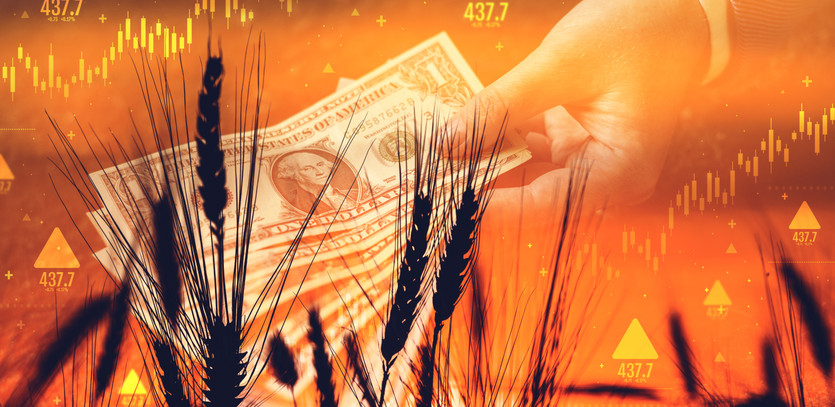The U.S. dollar isn't just another currency; it's a global powerhouse, responsible for an astonishing 59.23% of international reserves. But what gives the dollar this seemingly unshakeable status?
The Liquidity Lure
- Unparalleled liquidity: The dollar's liquidity is unmatched, making it an appealing choice for buying and selling around the globe.
- Central bank preference: This liquidity leads central banks worldwide to hold dollar reserves, strengthening its position.
- Stability and Influence: America's decades-long influence and political stability make its currency highly dependable.
The Import-Export Equation
- Consumer Magnet: The U.S. continues to be one of the world's largest consumer markets.
- Trade Dynamics: While exporting commodities like corn and soybeans, the U.S. is a giant importer of others.
- Pricing Standard: The interconnection between commodities and currency has crowned the U.S. dollar as the global benchmark for most commodity pricing.
The Dollar's Fluctuations and Commodity Prices: An Inseparable Connection
The intricate relationship between the value of the U.S. dollar and the world's commodity prices is more than a mere economic observation; it's an entwined dance of finance, capturing the attention of economists, traders, and policymakers alike. This connection isn't linear or simplistic; it’s a complex choreography that reveals itself through different periods and various market conditions.
Historical Trends: A Dance Through Time
The Rise and Fall: 2002 to 2014
- Bearing and Bulling (2002–2011): A fascinating phase began in 2002 with a protracted bear market in the dollar, corresponding to a secular bull market in commodities. This financial ballet continued for nearly a decade, where every dip in the dollar was met with a rise in commodity prices.
- The Pausing Period (2011–2014): In 2011, the dollar began to consolidate, gracefully resting before it started to ascend against other currencies by May 2014.
The Peaks and Valleys: Commodities in Spotlight
- Copper's Crown: Copper reached all-time highs of over $4.50 per pound.
- Golden Glory: Gold sparkled at over $1900 per ounce in 2011.
- Sweet Surge: Sugar, an essential global commodity, touched 36 cents per pound.
- The Descent Begins: But, like a well-orchestrated ballet, prices that soared began a gradual and significant descent starting in 2011.
The Effects of a Stronger Dollar: The Stronger, The Lower
The stronger the dollar grows, the more pronounced its effect on global commodities. A strong dollar is an influential dancer, leading the way. This segment provides an elegant snapshot of how the dollar's strength shapes commodity pricing:
2014's Surging Dollar: An In-depth Look
- The Commodity Dip: As the dollar began to rally, taking the index from lows of 78.93 to highs of over 100 in ten months, commodities responded by dipping below their historical highs.
- The Copper Collapse: Copper fell to a 2014 year low of $2.83 per pound.
- The Oil Odyssey: Oil took a dramatic tumble from over $107 per barrel in June of 2014 to under $45 by January of 2015.
- Sugar's Slide: Meanwhile, sugar's price descended to below 12 cents by March 2015.
The General Trend: Across the Commodity Spectrum
- Individual Nuances: It's important to recognize that commodities aren't a monolithic entity. Each has its own dance, shaped by supply and demand, such as the cattle market's high prices due to a global beef demand surge.
- The Unifying Factor: For the most part, however, the stronger dollar choreographed a fall in commodity prices as a whole.
The Visual Impact: A Rich Tapestry
- Graphical Insights: Imagining a graph with the dollar's value on the y-axis and time on the x-axis, one can see an artistic tapestry where the peaks and valleys of the dollar's value correlate inversely with commodity prices.
- A Dynamic Dance: This isn't a static image but a dynamic dance, full of ebbs and flows, telling a story that's rich in insights, patterns, and lessons.
A Pattern in the Chaos: The Inverse Connection
This dance isn't arbitrary; there's a pattern, a rhythm that pervades the chaos. The inverse connection between the dollar and commodities isn't a transient phenomenon but a core principle in global economics. This relationship reflects a fundamental truth about market behaviors and pricing mechanisms.
Specific Examples: When Numbers Tell the Tale
Q1 2015: A Case Study
- Dollar Index Increase: 8.97%
- Commodities Decrease: An average of 7.9% on futures markets
This correlation demonstrates the negative relationship that will likely endure as long as the dollar remains the pricing standard for global commodities.
The Future: New Reserve Currency on the Horizon?
Though merely speculative, the thought of a different currency ascending to the throne is intriguing. Should a usurper arise, it's conceivable that this new currency would mimic the dollar's intricate dance with commodities.
The Dollar and Commodities in Recent Years: 2016–2017
A Rally, A Respite: The Dance Continues
From May 2014 to March 2015, the dollar leaped like a ballet dancer, soaring over 27%, only to pause for a twenty-month intermission of consolidation. A new act began in November 2016, with the dollar gracefully rising once more, accompanied by a synchronized rebound in commodity prices.
Reaching New Heights: The Peak of 2017
Touching 103 in early January 2017, the highest level since 2002, the dollar's ascent was elegantly choreographed by the prospects of increased U.S. interest rates. This mesmerizing performance may pose challenges to the raw material value recovery if the dollar's appreciation continues in 2017.
Interest Rates: The Unseen Dance Partner
Higher real interest rates can be a bearish partner, making the dance floor more challenging for commodities. Despite individual supply-demand characteristics, a strong dollar and higher rates could dampen future commodity appreciation.
Conclusion: The Dollar's Dance - A Symphony of Economics
When analyzing commodity prices, understanding the dollar's technical and fundamental position is akin to understanding the rhythm of a dance. It's not merely a matter of numbers; it's a symphony of economics, a dance of influences that resonates globally.





